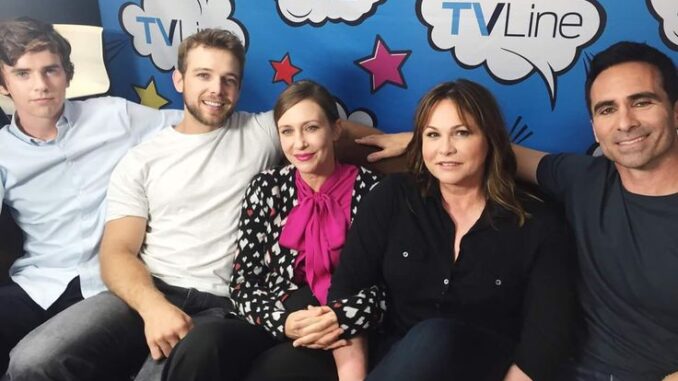
Freddie Highmore’s journey from wide-eyed child actor to the complex, emotionally rich lead of The Good Doctor is nothing short of extraordinary. Known for his soft-spoken demeanor and boyish charm, Highmore has quietly built one of the most respected acting careers of his generation—transitioning seamlessly from early roles in beloved films to commanding performances on some of television’s most watched dramas. But how exactly did the young boy who captured hearts in Charlie and the Chocolate Factory become the nuanced, Emmy-worthy Dr. Shaun Murphy?
Let’s take a look at the fascinating evolution of Freddie Highmore—a journey marked by talent, intelligence, and a quiet determination to grow as an artist on his own terms. Born in London in 1992, Alfred Thomas Highmore—nicknamed Freddie—was surrounded by entertainment from a young age. His mother was a talent agent, and his father, Edward Highmore, was an actor. Despite the industry connections, Freddie’s early rise was built on merit. His screen debut came at just seven years old in the 1999 comedy Women Talking Dirty, but it was his breakout role in Finding Neverland (2004), opposite Johnny Depp and Kate Winslet, that brought him international attention.
Critics were stunned by his emotional depth as Peter Llewelyn Davies, the real-life inspiration for Peter Pan. At just 12, he earned several awards and nominations, setting the tone for a career defined by intelligence and subtlety.
Following Finding Neverland, Highmore starred in Charlie and the Chocolate Factory (2005), again opposite Johnny Depp. His portrayal of Charlie Bucket was widely praised for its warmth and sincerity—making him a household name almost overnight. He also voiced characters in animated features and starred in fantasy films like The Spiderwick Chronicles (2008) and August Rush (2007), proving his range even as a teen.
But unlike many child actors who fizzle out under the pressure of fame, Highmore made a conscious decision to step back from the spotlight when needed. Rather than chasing fame, he pursued education, balance, and personal growth—choices that would later shape his mature approach to acting.
At the height of his fame, Highmore surprised fans by enrolling at Cambridge University, where he studied Spanish and Arabic. This decision was no career detour—it was a deliberate choice to broaden his worldview, sharpen his mind, and build something beyond his filmography.
During this time, he worked sporadically, choosing roles carefully and staying out of tabloids. This academic grounding helped him avoid the pitfalls of childhood fame and gave him the tools to return to Hollywood as a fully formed adult performer.

Freddie Highmore’s true reinvention came in 2013 with the A&E series Bates Motel, a prequel to Alfred Hitchcock’s Psycho. Cast as Norman Bates, the deeply troubled young man who would eventually become one of cinema’s most famous villains, Highmore stunned audiences with a chilling, emotionally layered performance that spanned five seasons. His portrayal was a slow-burning descent into madness, blending vulnerability and darkness in a way few actors could manage. It was the role that proved Highmore could carry a series—and introduced the world to a more mature, risk-taking version of the actor.
In addition to starring in the show, Highmore also began writing and directing episodes, a behind-the-scenes evolution that revealed his interest in storytelling beyond acting. In 2017, Freddie Highmore took on the role that would define the next phase of his career: Dr. Shaun Murphy, an autistic surgical resident with savant syndrome, in The Good Doctor. The series, adapted from a South Korean drama, was a gamble—casting an English actor to play an American doctor with a neurodevelopmental disorder was a risk that required sensitivity, research, and immense emotional commitment.
Highmore’s portrayal was met with critical acclaim. He approached Shaun with empathy, nuance, and authenticity, avoiding clichés and instead highlighting the complexity of a character who thinks and communicates differently.
Highmore didn’t just act in the series—he became one of its executive producers, contributing to the show’s creative vision. He also wrote and directed several episodes, proving his multifaceted talent and deep investment in the story.
Under his leadership, The Good Doctor became one of ABC’s most-watched dramas, and Shaun Murphy became a new kind of TV hero: intelligent, awkward, vulnerable, and immensely capable. Highmore’s performance was praised not only for its emotional depth but for its role in raising awareness about autism and neurodiversity.
What sets Freddie Highmore apart from many of his peers is his thoughtful approach to fame and career choices. He isn’t loud on social media. He rarely does tabloid interviews. He picks roles that challenge him intellectually and emotionally, and he prefers substance over spectacle.
Despite the pressures of stardom, Highmore remains grounded, often crediting his upbringing, education, and love of language and literature for his centered perspective. He’s known to be fiercely private, incredibly well-read, and multilingual—a modern Renaissance man in an industry that often favors hype over humility.
He also continues to advocate for more thoughtful, inclusive representation on screen. His portrayal of Shaun has sparked conversations about inclusion, difference, and the power of representation—not through dramatic speeches, but through lived experience and human connection.
